Where Are The Jacking Points On A Car?
Jack Dreyer | Friday 7th October 2022 12:00pm

If there’s something mechanically wrong with your car, the chances are you’ll have to jack it up at some point. Jacking up a vehicle is quite difficult, though, and should be done with extreme caution due to the heavy weights involved.
Even just raising part of your car off the floor a few centimetres or to change a tyre can seem daunting if you’ve never done it before. One of the most important parts about jacking a car up, however, is finding the correct jacking points. While these core areas may seem obvious to some drivers, to others it can be difficult to know where to start.
If you’re unsure about the jack points on your car and how to go about jacking up a vehicle, read on.
Why is it important to use the right jacking points?
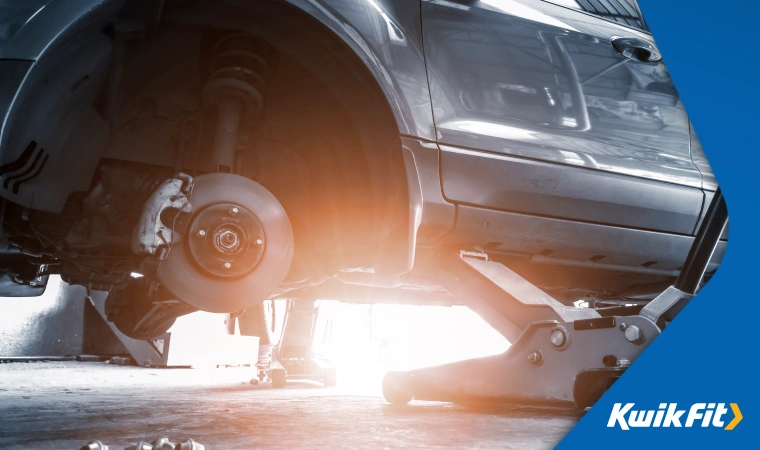
First of all, let’s establish exactly why there are specific ‘jacking points’ in the first place. What is the need for such precise locations when jacking up a car? And, why can’t we just use any old place for jacking?
For a start, if you fail to place the car jacks correctly underneath your vehicle, it could seriously damage the vehicle or, in some cases, those working underneath it if it slips. Parts of the undercarriage of the car could get punctured or bent — and this is by no means a cheap or easy repair.
Older vehicles were built on a heavy-duty frame that could withstand jacking pressure, However, newer models are more optimised for fuel efficiency and usually have a ‘unibody construction’ or a sheet that is far less resistant to force. Instead of frames, there are reinforced metal strips running along the edge of the car, though.
Which car jack should you use?
As well as specially designed jacking points, the jacks themselves are well engineered to be able to cope with heavy loads for extended periods of time. There is a whole range of different types of jack that you might like to consider, but the main types are:
Scissor jacks
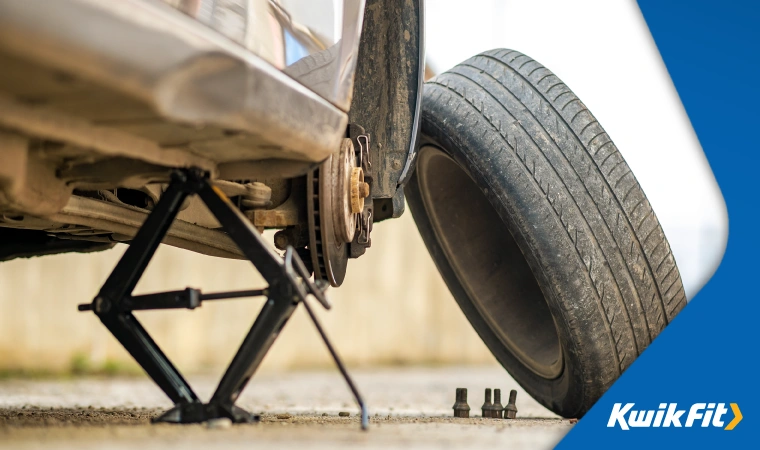
Scissor jacks always used to be the most popular type of car jack. They would come as standard with many cars and vans to aid in the emergency repair of flat tyres. However, now, since run-flat tyres are becoming increasingly popular, this type of jack is fading out in its use.
They are still optimal for jacking up a car when changing tyres, though. But, for other tasks that require a car to be jacked, we recommend using a different jack type as scissor jacks have been known to slip over occasionally.
Hydraulic bottle jacks
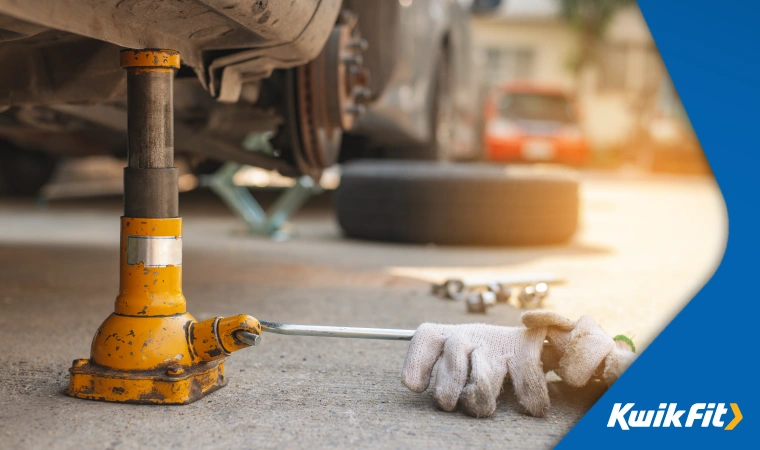
This type of jack is very small and compact. As such, it is excellent for smaller cars and being kept in the boot out of the way in case of emergencies. However, it is not the best option when it comes to SUVs and larger vehicles that require jacking up farther from the ground.
Similarly to the scissor jack, this jacking option can sometimes be unstable as it has a smaller surface area. To remedy this if you have no other option, make sure to carry a baseplate to balance it out - this can be made from a sheet of metal or hard plywood.
Hydraulic trolley jacks
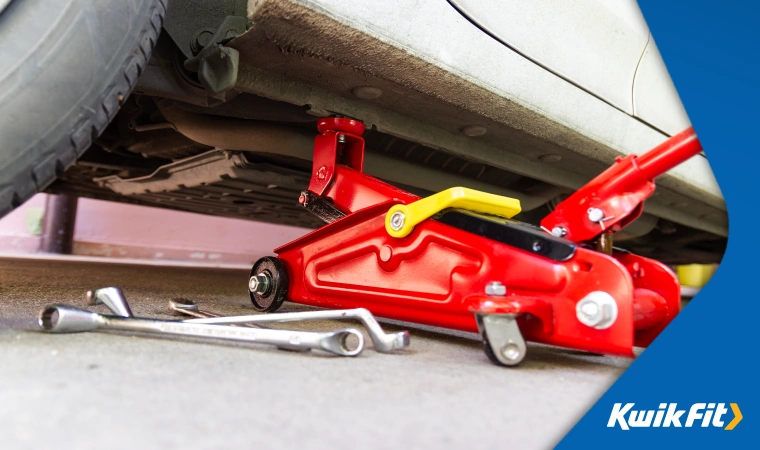
Lastly, hydraulic trolley jacks are a great option if it’s stability you’re looking for. They work in a mechanically-similar way to the bottle jacks above — but they come on four wheels and can be rolled about.
They are significantly larger and more stable. However, due to their size, weight, and general bulk, they aren’t the easiest option to carry around in the car and are more suited to life in the garage.
Where are the jack points on your car?

Now for the tricky part: finding the jacking points on your own vehicle.
Due to the huge variety in cars nowadays, there is not a universal jacking point location. That is, they are likely to differ in location based on the size, age, model, and make of your car. That being said, there are certainly common places and clues to help.
Start by looking in your vehicle’s user manual or maintenance guide. This should identify the jacking points clearly for you. If you’ve bought your car second-hand or have had it for a number of years, you may not have access to the user manual anymore — don’t panic, we’ll guide you through it.
Begin your search by looking at the chassis around each of the four wheels. You should look for a reinforced chassis area. Below are some of the common car jacking up points:
1. Near the front & rear wheel
When it comes to changing car tyres, the most ideal place is near the front wheel or near the rear wheels. This doesn't lift up the entire car at once, but a part of it. You can move the jack from one wheel to another while changing the tyres using this method. What’s more, place the jack so close to the wheel to prevent slipping.
2. On the rear differential
This area is hands-down the safest jacking point. Why? Because it is able to balance the entire weight of the car. You would make use of this jacking point while replacing something like bushings or leaf springs, or when modifying the chassis or height of your car. This also allows you to easily access the underneath of a car, giving you the most space.
3. On the front & rear crossmembers
These two jacking points must be used in conjunction with one another as the car will not balance with only one. The rear crossmember point is excellent for checking the back part of the car, while the front one is optimal for procedures like oil changes as it allows the tank to be supported and the front of the car to be inspected.
4. On both sides of the body
Lastly, it is possible to jack a car up by using specific points on both sides of the body. However, this one is tricky and quite dangerous as the car may slip. As we have said before, this may also cause damage to the bodywork if the jacking is not done properly. It is useful though for assessing the underneath of the car in its entirety.
How to jack up a car
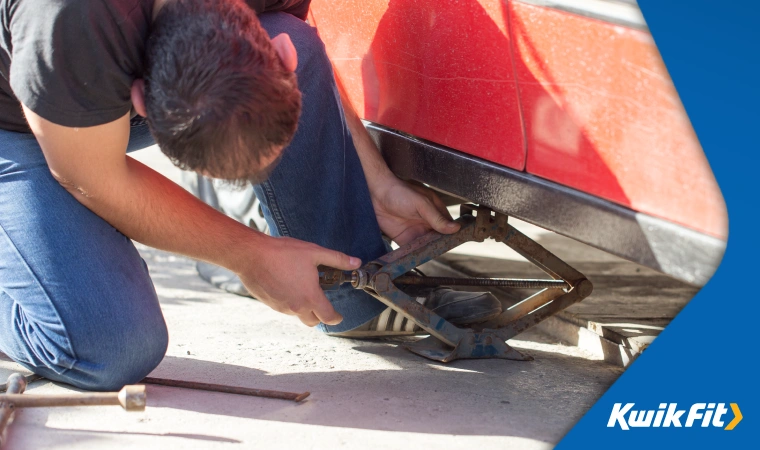
Now you know where you can jack your car up from safely, it’s time to learn how by using the following steps:
- Place your jack underneath the car. The head of the jack should pretty much touch the jacking point.
- Begin to apply pressure onto the jacking point by adjusting the jack. Some drivers like to use a piece of wood to protect the jack head here. You can jack quickly at first as it may take some time.
- Begin to jack slower once you notice the jack has been locked in by the pressure. The car doesn’t need to come off the ground much for a tyre to be removed!
- Once the wheel is able to roll, that’s when you know you’ve jacked it up enough for a tyre change.
Speak to Kwik Fit
Jacking up a car can be really tricky and does require a lot of know-how and elbow grease. So, if you’re worried about changing a tyre or inspecting a vehicle part yourself under a jacked-up vehicle, it’s better to leave it to the experts at Kwik Fit. Speak to the technicians at your local Kwik Fit today.
Any facts, figures and prices shown in our blog articles are correct at time of publication.
Featured Articles
Is it Illegal to Drive With One Headlight?
Saturday 19th July 2025
Wondering if it’s illegal to drive with one headlight? Learn about the safety risks and penalties of illegal blown bulbs and why you should fix them promptly.
Air Con in EVs & Hybrids: Experts Answer Your Questions
Monday 30th June 2025
Does air con drain EV batteries? Can you use the air con while charging an electric car? Find out the answers to these questions & more from Kwik Fit’s experts.
Why Is Your Car Making a Noise? Fixes & Tips
Friday 13th June 2025
When your car starts making unexpected noises, it can certainly be quite disconcerting; it may be nothing to worry about, but here’s what you need to know.









